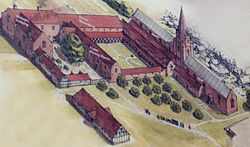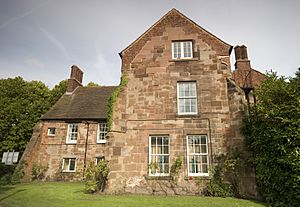Franciscan Friary, Lichfield facts for kids

Artist's impression of the Friary
|
|
| Monastery information | |
|---|---|
| Order | Franciscan Friars |
| Established | 1237 |
| Disestablished | 1538 |
| Architecture | |
| Heritage designation | Scheduled Ancient Monument |
| Site | |
| Location | Lichfield, Staffordshire |
| Coordinates | 52°40′55″N 1°49′48″W / 52.68191°N 1.83008°W |
| Visible remains | floor slab of cloister and nave, Bishops Lodging |
| Public access | Yes |
The Franciscan Friary was once a large religious site in Lichfield, Staffordshire. It was home to a group of Franciscan Friars from 1237. A friary is like a monastery, where monks or friars live and work. This one had a big church, a cloister (a covered walkway), dormitories, and other buildings.
In 1538, King Henry VIII ordered the Friary to close down. Most of its buildings were torn down. Today, the site is a Scheduled Ancient Monument. This means it's protected because of its historical importance. You can still see the excavated ruins of some original buildings. A few original parts are still standing near the Lichfield Library.
Contents
History of the Friary
The Friars Arrive
The Franciscan Friars were a group of monks started by St Francis of Assisi in 1209. They believed in living a simple life. In 1237, some of these friars came to Lichfield to build their home. People in town called them the "Grey Friars" because of their grey robes. The Bishop of Lichfield, Bishop Stavenby, helped them get started. He gave them land to build their friary.
The Friary received many generous gifts over the years. These gifts helped them build up their estate. In 1237, King Henry III gave them oak trees from local forests for building. He also gave them money. In 1241, the Sheriff of Lichfield was told to provide clothes for the Friars. In 1286, King Edward I gave them 8 more oak trees from Cannock Chase for building.
Fire and Rebuilding
In 1291, a big fire broke out in Lichfield. It destroyed the Friary. But the Friars were still treated well by the town. The Friary was quickly rebuilt after the fire. In 1301, a water fountain called the Crucifix Conduit was built near the Friary gates. A man named Henry Champanar gave the Friars free water from his springs. The Crucifix Conduit stayed there until the 1800s.
The Friars lived a simple life. They promised to be poor, pure, and obedient. They spent most of their time preaching and helping the poor and sick people of Lichfield. Because of their good work, they kept getting gifts. This made them quite wealthy, even though they didn't plan to be. With this wealth, their simple wooden buildings became large stone structures. The Friary site grew to cover 12 acres. Their church was very large, with a nave (main part) that was 110 feet long and 60 feet wide. The cloister was 80 feet square.
The Friary Closes Down
By 1534, King Henry VIII needed a lot of money. He decided to take the wealth from the Church. In 1535, his minister Thomas Cromwell ordered a check of all church property. He also checked if the monks were following their rules strictly. Using this information, in 1536, he got a law passed. This law closed down all religious houses that were not very wealthy. Their property then belonged to the King. Much of this property was sold to make money for the King. In 1538, the Franciscan Friary in Lichfield was closed after 301 years.
After the Friary Closed
After the Friary closed, most of the site was cleared. It was sold for £68 to give money to the King. The church, cloisters, dining hall, and most other buildings were torn down. Only two buildings survived: the Dormitory and a house called ‘Bishops Lodging’.
These two buildings formed an L-shape on the 10.5-acre site. They were made of red sandstone in the early 1500s. These buildings became a home for many different owners for about 370 years. Gregory Stonyng bought the estate and buildings in 1544. He changed the buildings to be his own home. The estate was bought and sold many times until 1920.
In 1920, the 11-acre estate was sold to Sir Richard Ashmole Cooper. He was a Member of Parliament. Sir Richard gave the land to the city. He wanted them to develop the area and build a new road. By 1920, the streets in Lichfield were very crowded with cars. The west side of Lichfield was still mostly undeveloped.
In 1928, the road called ‘The Friary’ was built across the old Friary site. Building this road meant moving the clock tower. It also meant tearing down buildings on St John's Street. Much of the remaining Friary buildings were also demolished. Some parts of the torn-down buildings were used to build a public toilet near Beacon Park. Lady Cooper officially opened the new roads in April 1928.
The Bishops Lodging was the only part of the original Friary that survived the road building. When the new Friary Girls School was built in 1921, the Bishops Lodging was made part of the school building. The Friary School moved to a new location in 1975. Today, the building is the Lichfield Library. You can still see the original part of the Friary in the southwest section of the Library building.
In 1933, the old church site of the Friary was going to be developed. Councillor Thomas Moseley got permission to dig and find out more about it. The dig showed how big the ruins were and where the buildings used to be. The site then became a Scheduled Ancient Monument. This stopped any building on the site. Now, the site is a public garden. You can see the outlines of the cloister walls on the ground. Parts of the church's north wall are also visible. A classical-style entrance was put up in 1937. This entrance came from Shenstone Court, Sir Richard Cooper's home.
The Friary's history is still important in Lichfield today. Many places are named after it, like the Friary School, Friary Tennis Club, and Friary Gardens.
Images for kids




